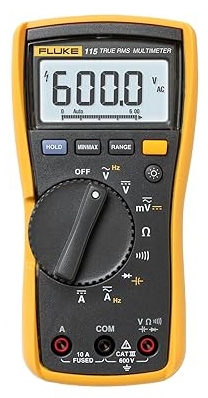Safe use of multimeter functions
See also System Component Testing
- AC – (Alternating current) will show a wavy line with dots diagonally opposite or ACV.
- DC – (Direct current) will show a straight line with dots below or DCV. (measures a steady reading).
Typical ranges for digital multimeters are:
- DC Voltage: 200mV, 2000mV, 20V, 200V, 600V
- AC Voltage: 200V, 600V
- DC Current: 200μA, 2000 μA, 20mA, 10mA
- OHMS scale will show an uppercase omega symbol of Ω. (Resistant of movement).
- Resistance: 200Ω, 2000Ω, 20KΩ, 200KΩ
- Continuity buzzer will show the symbol of ⁾⁾⁾.
- (buzz = closed circuit / continuous circuit / zero resistance)
- (no buzz = open circuit / no continuous circuit / infinity / OL).
Black test lead always goes into COM terminal on the multimeter (first).
Red test lead always goes into VΩ or ACV or V~ terminal on the multimeter (second).
- Always select voltage range above 240v as less than this will read off the scale when measuring for mains voltage and never rotate the dial while the meter is connected to a circuit – you may rotate it through a current range, short-circuiting the probes and damaging either the meter or the circuit.
- When measuring across L and N parts of a circuit (motor windings), a reading of zero resistance indicates a fault (short circuit).
The resistance readings in motor windings will vary (pumps, fans, solenoids, transformers). - When measuring closed switches (micro switches, overheat cut out stats) a reading of zero resistance (closed-circuit / continuity) = ok.
- When measuring open switches (micro switches, overheat cut out stats) a reading of infinity / OL (open circuit / no continuity) = ok.
- When measuring in volts AC the black test lead must first be connected to E or N connections and then secondly the red test lead be connected to the L connection, which then completes the circuit.
- All electrical test equipment used should be suitable for the electrical tests being carried out and any leads/probes to be inspected before use to ensure it is safe.
Respect the circuitry you are working on – If you touch exposed metal, or cause a short circuit, or connect to high voltage, you may expose yourself to a serious hazard.
- Although more expensive, an auto-ranging multimeter is far easier as it automatically adjusts its range to give a meaningful reading. Some of the ranges typically displayed on a multimeter will rarely be used if at all by gas engineers.
- The main ranges typically used are AC, DC, and continuity – keep it simple rule!
- The gas operative should ensure they have sufficient knowledge of the test equipment’s capabilities and functions so as to be able to conduct electrical testing in a safe manner.
WHERE ANY DOUBT EXISTS –
ALWAYS FOLLOW MANUFACTURERS SAFETY INSTRUCTIONS.
